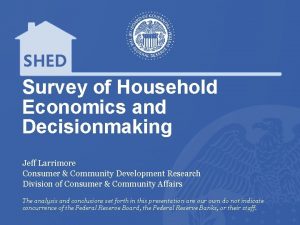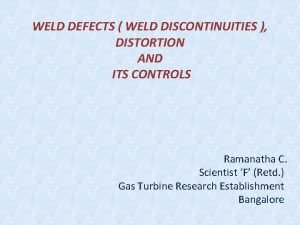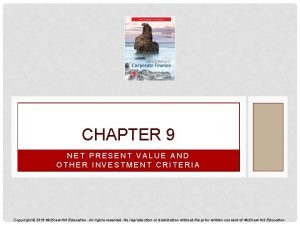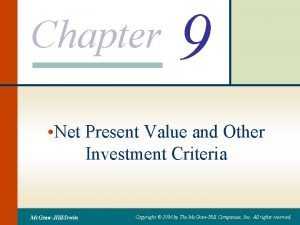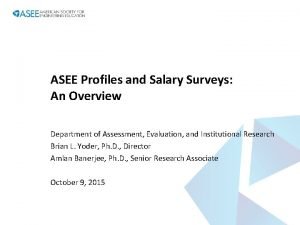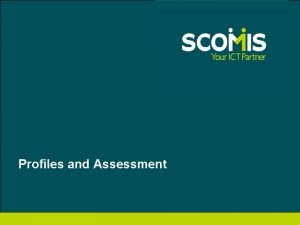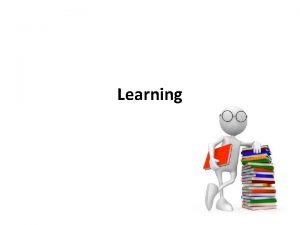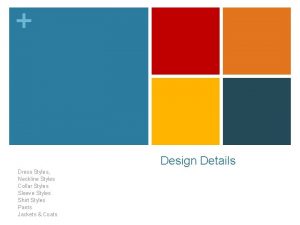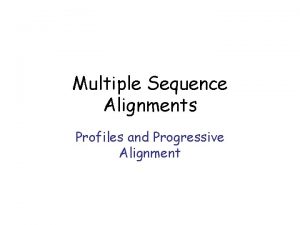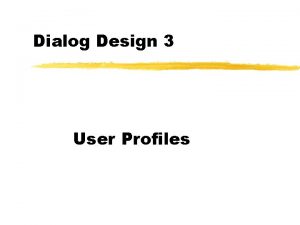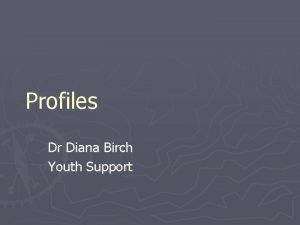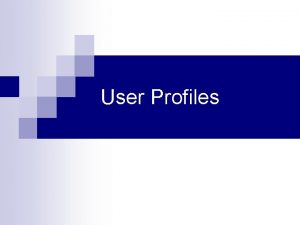From Career DecisionMaking Styles to Career DecisionMaking Profiles




















- Slides: 20

From Career Decision-Making Styles to Career Decision-Making Profiles: A Multidimensional Approach Itamar Gati, Shiri Landman, Shlomit Davidovitch, Lisa Asulin-Peretz, and Reuma Gadassi The Hebrew University of Jerusalem

The four facets for assessing career clients’ needs n Locating the focuses of the client’s career decisionmaking difficulties n Appraising the degree to which the client’s preferences are crystallized n Assessing the client’s decision-making status n Assessing the client’s career decision-making profile (style): interventions aimed at facilitating career decision making should be tailored to the client’s career decision-making profile 2

Previous approaches n Previous approaches have often focused on classifying individuals into one of few types based on their most dominant style (e. g. , rational, intuitive, dependent; Harren, 1979; + spontaneous and avoidant, Scott & Bruce, 1995). n The problem: labeling individuals by a single dominant characteristics is an oversimplification 3

Our approach n We suggest to consider 12 dimensions simultaneously, while referring to career decisionmaking profiles rather than career decisionmaking styles. n We use “profile” instead of “style” for two main reasons: ¨ we are dealing with a multidimensional construct rather than with a single dominant trait; and ¨ “style” implies personality characteristics, whereas “profile” refers to both personality and situational influences on the decision-making behavior 4

Developing the Multidimensional Model Comparing the most common 16 prototypes deduced from 40 types in previous research From this list we derived 12 basic dimensions Defining the high and low pole of each dimension (e. g. , for information processing: “analytic" vs. "holistic”) Refining the model on the basis of preliminary empirical tests (5 samples, N=2764) 5

Assumptions underlying the multidimensional model: n n individuals differ in their approach to making career decisions and thus in their characteristic profile of career decision making individuals’ career decision-making process can be better described by a multidimensional profile rather than by a single dominant characteristic each dimension describes a continuum between two extreme poles, along which the individual can be characterized the dimensions are not independent; nevertheless, each has a unique contribution 6

Assumptions underlying the multidimensional model (Cont. ): n like personality-related measures (and unlike career decision-making difficulties) the dimensions cannot be combined to produce a single total score n depending on the dimension, some poles are more adaptive for decision making than others n whereas some dimensions are mainly personalityrelated and more consistent across situations, others are more situational and may depend on the specific decision task or the stage of the decisionmaking process in which the individual is at 7

The 12 Dimensions n n n IG - Information gathering (much vs. little) IP - Information processing (analytic vs. holistic) LC- Locus of control (internal vs. external) EI - Amount of effort invested in the process (much vs. little) PR - Procrastination in entering the process (low vs. high) SP - Speed of making the final decision (fast vs. slow) CO - Consultation with others (frequent vs. rare) DO - Dependence on others (low vs. high) DP - Desire to please others (low vs. high) AI - Aspiration for an "ideal occupation" (low vs. high) WC - Willingness to compromise (high vs. low) IN - Intuitive (much vs. little) 8

The 12 Dimensions n Information gathering (comprehensive vs. minimal) – the degree to which individuals are meticulous and thorough in collecting and organizing information. n Information processing (analytic vs. holistic) – the degree to which the individual analyzes information into its components, and processes the information according to these components. n Locus of control (internal vs. external) – the degree to which individuals believe they control their occupational future and feel that their decisions affect their career opportunities, or that these are mainly determined by external forces such as fate or luck. n Effort invested in the process (much vs. little) – the amount of time and mental effort individuals invests in the decision-making process.

The 12 Dimensions n Procrastination (high vs. low) – the degree to which the individual avoids or delays beginning or advancing through the career decision-making process. n Speed of making the final decision (fast vs. slow) – the length of time individuals need to make their final decision once the information has been collected and compiled. n Consulting with others (frequent vs. rare) – the extent to which individuals consult with others during the different stages of the decision process. n Dependence on others (high vs. low) – the degree to which individuals accept full responsibility for making their decision (even if they consult with others), as opposed to expecting others to make the decision for them.

The 12 Dimensions n Desire to please others (high vs. low) – the degree to which the individual attempts to satisfy the expectations of significant others (e. g. , parents, partner, friends). n Aspiration for an ideal occupation (high vs. low) – the extent to which individuals strive for an occupation that is perfect for them. n Willingness to compromise – the extent to which individuals are willing to be flexible about their preferred alternative when they encounter difficulties in actualizing it. n Intuition –(much vs. little) - the degree to which individuals rely on internal (gut) feelings when making a decision.

The Career-Decision-making Profile Questionnaire (CDMP) n 36 statements (3 items x 12 dimensions) n Response scale: 1 - Strongly disagree to 7 -Strongly agree n The CDMP is embedded in WWW. CDDQ. ORG 12

Results - CDMP n n Reliabilities of the 12 Dimensions (Cronbach Alpha): ¨ Sample 1 (N=208) – median=. 79 , Min. 70, Max. 89 ¨ Sample 2 (N=431) – median=. 81 , Min. 74, Max. 91 Reliabilities Test-Retest (N=212): Test-retest (4 months) consistency: median=. 70, Min. 52, Max. 83 ¨ Test-retest (2 weeks) reliability: median=. 84, Min. 75, Max. 86 ¨ n Among the Most Stable dimensions: DO – Dependence on Others (r =. 79) ¨ DP – Desire to Please others (r =. 78) ¨ n Least Stable dimensions: WC - willingness to compromise (r =. 52) ¨ CO - consultation with others (r =. 60) ¨ 13

Associations between CDMP and GDMS (Scott & Bruce, 1995; N=427 ) GDMS Scales 1 CDMP Scale 2 Rational Intuitive Dependent Avoidant Spontan IP . 62 -. 05 . 03 -. 17 -. 26 4. 73 1. 29 . 75 IG . 40 -. 12 -. 08 -. 32 -. 47 4. 73 1. 41 . 75 LC . 23 -. 32 -. 17 -. 31 -. 42 5. 22 1. 42 . 77 EI . 53 -. 03 . 07 -. 21 -. 22 5. 26 1. 23 . 81 SP -. 08 -. 01 -. 36 -. 48 -. 10 2. 96 1. 45 . 81 PR -. 26 . 06 . 23 . 81 . 32 4. 05 1. 80 . 88 CO . 02 -. 07 . 52 . 05 -. 20 5. 47 1. 33 . 77 DO -. 19 . 04 . 48 . 43 . 31 2. 54 1. 47 . 82 DP -. 18 . 05 . 38 . 34 . 29 2. 90 1. 42 . 85 AI . 19 . 10 . 00 -. 18 . 07 5. 20 1. 38 . 76 WC . 00 . 02 . 21 . 23 . 15 3. 96 1. 54 . 88 IN -. 16 . 70 . 01 . 21 . 36 4. 03 1. 34 . 83 Mean 3. 83 3. 17 3. 73 2. 99 2. 28 SD Cα 0. 78 0. 77. 83 0. 85. 82 1. 09. 89 0. 85. 81 Mean SD Cα 14

Associations between CDMP and VDSI (Walsh, 1986; N=427 ) CDMP Scale 2 VDSI Scales 1 TF IE Mean SD Cα IP . 55 . 07 4. 66 1. 31 . 78 IG . 65 . 07 4. 74 1. 46 . 81 LC . 28 . 11 5. 20 1. 31 . 74 EI . 42 -. 12 5. 20 1. 28 . 82 SP . 11 . 31 3. 00 1. 51 . 84 PR -. 45 -. 14 4. 04 1. 73 . 86 CO . 12 -. 59 5. 38 1. 25 . 74 DO -. 29 -. 37 2. 63 1. 53 . 83 DP -. 21 -. 36 2. 82 1. 44 . 85 AI . 12 . 00 5. 06 1. 30 . 70 WC -. 18 -. 07 3. 92 1. 50 . 87 IN -. 43 -. 03 1. 17 -0. 65 4. 25 1. 34 . 82 1. 21. 83 1. 19. 81 Mean SD Cα 15

Means of the 12 CDMP Scales by three Levels of Decision Status (N = 427) RCA - Decision Status CDMP ANOVA F(2, 394) p< η 2 5. 30 7. 65 . 03 5. 22 5. 74 3. 48 . 05 . 02 2. 78 2. 99 4. 36 16. 29 . 001 . 07 PR 4. 48 3. 89 2. 28 26. 50 . 001 . 11 DO 2. 97 2. 44 1. 78 11. 90 . 001 . 05 DP 2. 92 2. 77 2. 50 1. 37 ns . 01 AI 5. 02 5. 07 5. 21 0. 31 ns . 00 WC 4. 16 3. 82 3. 11 7. 76 . 001 . 04 IN 4. 43 4. 10 4. 08 3. 34 . 05 . 02 Scale Beginning During After (n = 196) (n = 199) (n = 32) IG 4. 46 4. 92 LC 5. 09 SP 16

Incremental Validity of the CDMP n The five GDMS styles accounts for 45. 1% of the variance in the decision-status-group membership. n The GDMS styles combined with the CDMP dimensions accounts for 52. 1% of group membership variance. n But, the CDMP dimensions alone accounts for 50. 4% of the variance. n Conclusion: The CDMP better predicts decision-statusgroup membership than the GDMS 17

Conclusions & Implications n The proposed and tested model can be used to characterize individuals' career decision-making n There are dimensions in which one of the poles appears more adaptive n The CDMP allows a more accurate assessment of the counselee's career decision-making profile, thus better “tailoring” the intervention to the individual n The CDMP allows individuals to learn about their career decision-making profile, and thus to consider adopting more adaptive strategies 18

Future challenges n Further testing and validating the dimensions in terms of which poles are the more adaptive n Expanding research related to the relations between career decision-making profile and other career-related factors (e. g. , dysfunctional thoughts, preference crystallization, career decision-making difficulties) n Attempting to locate groups of individuals with similar career decision-making profiles n Designing interventions to help clients adopt career decision-making profiles that are more adaptive 19

For further information: www. cddq. org itamar. gati@huji. ac. il 20
 Survey of household economics and decisionmaking
Survey of household economics and decisionmaking Learning styles for career development
Learning styles for career development Corporate traveller profile
Corporate traveller profile Excessive concavity welding
Excessive concavity welding Npv profiles
Npv profiles Who is jean louise
Who is jean louise Process discriminants in software project management
Process discriminants in software project management Capital budgeting
Capital budgeting H.264 profiles and levels
H.264 profiles and levels Tectonic hazard profiles
Tectonic hazard profiles Mining company profile doc
Mining company profile doc Advantage and disadvantage of npv
Advantage and disadvantage of npv Modified internal rate of return
Modified internal rate of return Aitsl leadership profiles
Aitsl leadership profiles Alma publishing profiles
Alma publishing profiles Asee profiles
Asee profiles Specific flashing profiles
Specific flashing profiles Jean louise finch character traits
Jean louise finch character traits Cisco voice translation-rule
Cisco voice translation-rule Chapter 9 capital budgeting answer key
Chapter 9 capital budgeting answer key Diagnosing your cultural intelligence
Diagnosing your cultural intelligence
